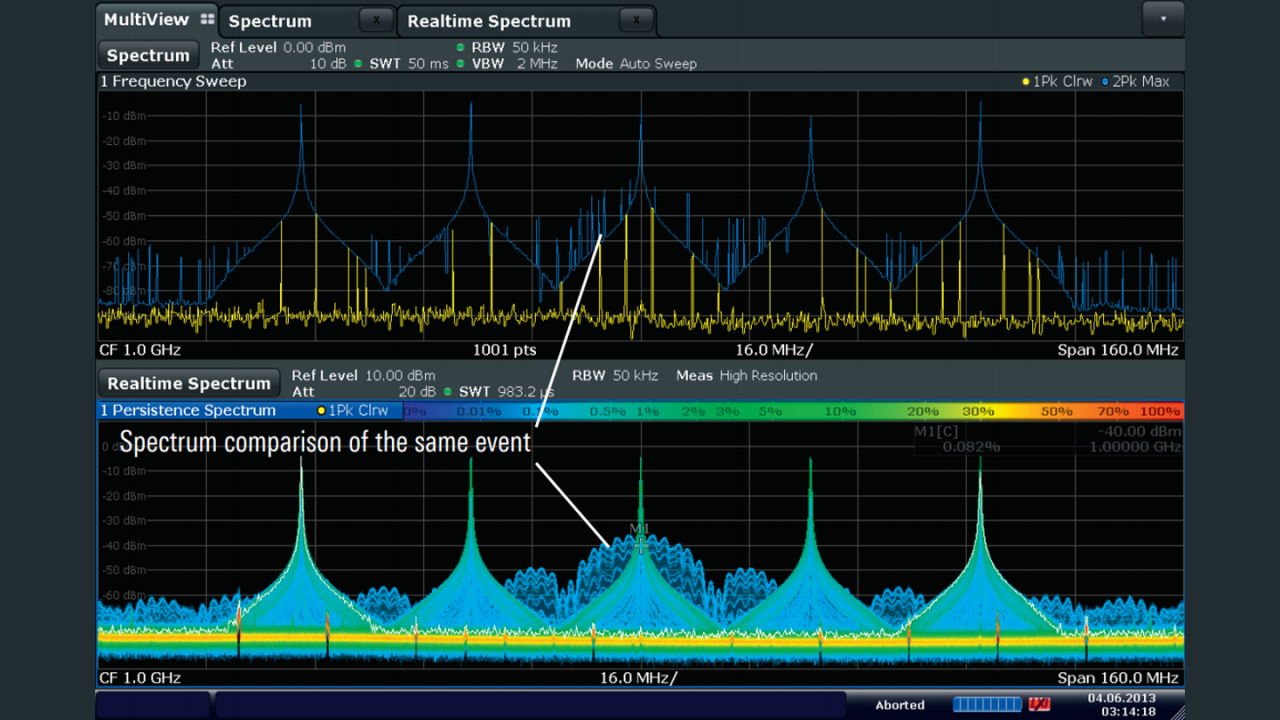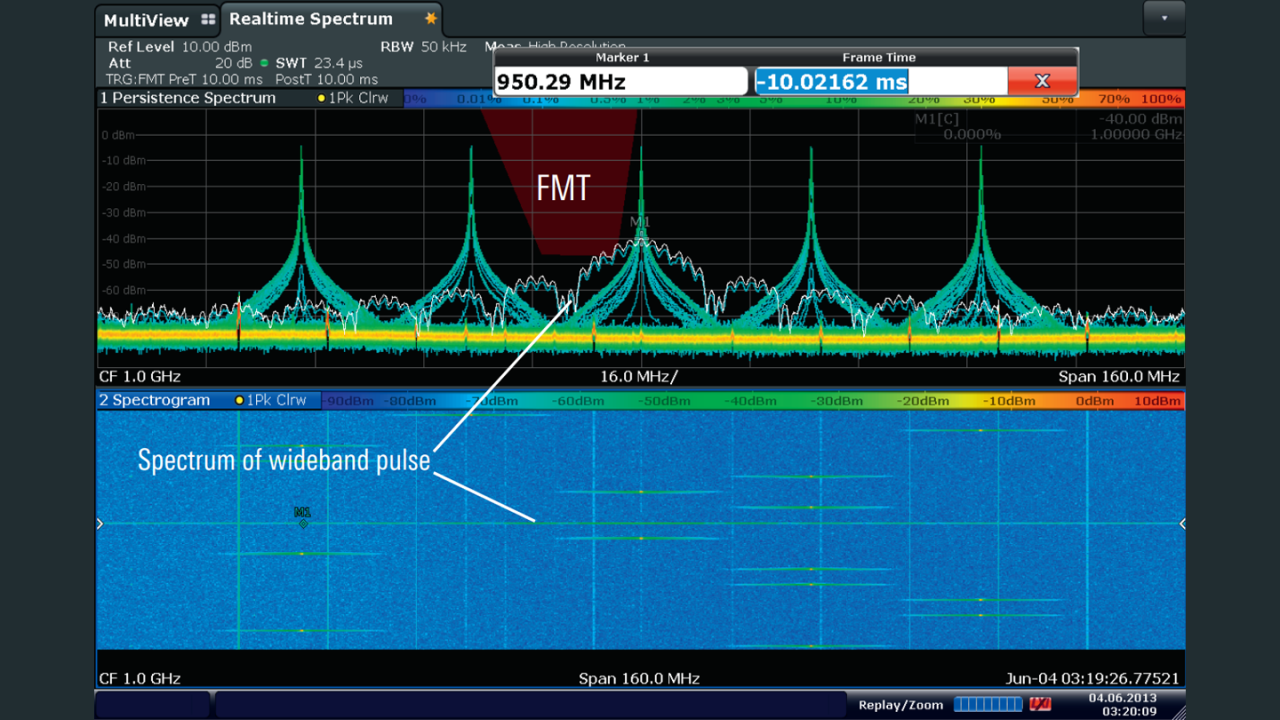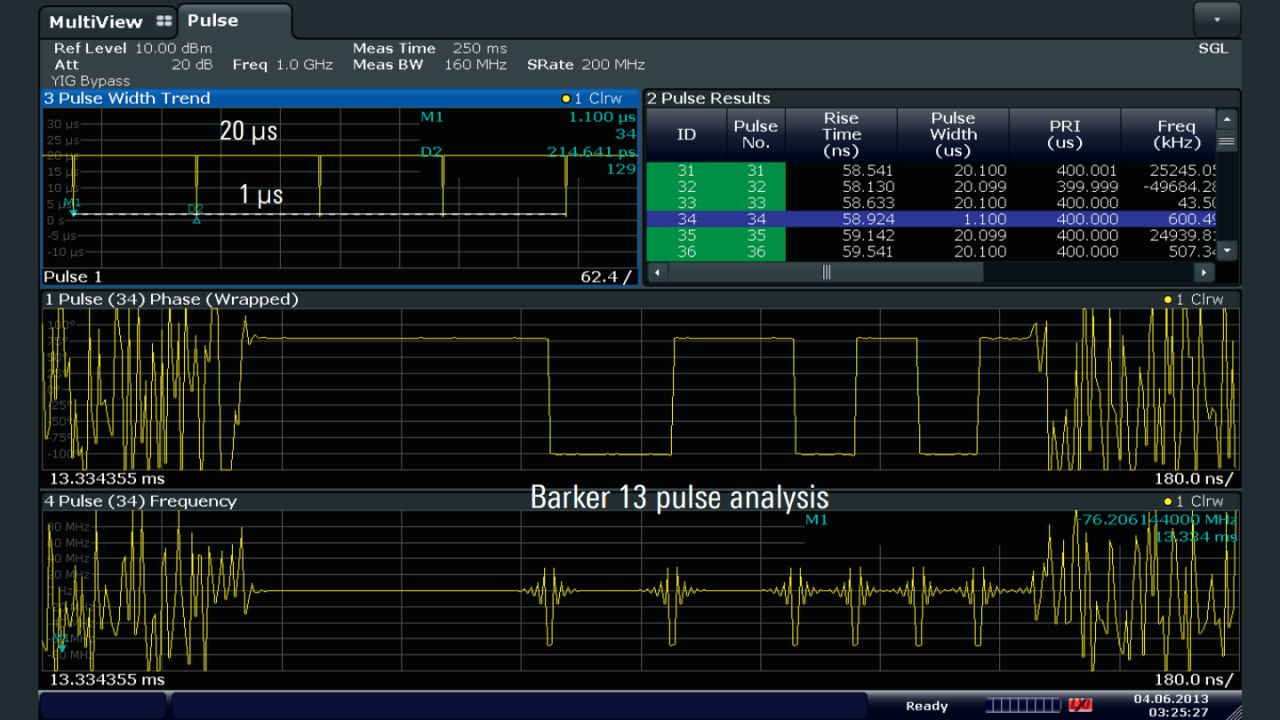Simplified analysis of frequency agile radars
The R&S®FSW signal and spectrum analyzer with the R&S®FSW-K160R realtime option and the R&S®FSW-K6 pulse measurement option is ideal for testing modern radars.

The R&S®FSW signal and spectrum analyzer with the R&S®FSW-K160R realtime option and the R&S®FSW-K6 pulse measurement option is ideal for testing modern radars.


Frequency agility techniques enable radars to quickly change modes of operation on a pulse-to-pulse basis. This can include a variety of system operation capabilities:
These advanced system operations must be thoroughly tested to validate performance under these dynamic conditions and ensure that there are no undesired emissions. Unintentional spectrum emissions not only degrade the radar´s efficiency, they can also leave unintended artifacts. Sources of undesired emissions can occur due to transients and modulation errors, digital to RF coupling, nonlinear effects and power glitches, and even timing errors from hardware tuning and clock synchronization. These temporal spurious signals are difficult to detect using traditional test equipment due to the very fast nature of the signals.


Fig. 1: The R&S®FSW persistence spectrum display (bottom) instantly shows a different spectrum on the center frequency event which is hardly visible on the frequency sweep display (top) with max. hold trace.
Traditionally, swept spectrum analyzers have been used for searching for unwanted inband or out-of-band spurious signals. Even though the R&S®FSW signal and spectrum analyzer has the highest dynamic range and fastest sweep capability of any commercially available spectrum analyzer, the architectural limitations of traditional swept analysis are not ideal for observing short pulse events with a low probability of occurrence.
The signal conditions in Fig. 1 show the spectrum of a frequency hopping sequence in a 160 MHz span. Two displays are shown for comparison. Like a traditional swept spectrum analyzer, the frequency sweep display (top) has a max. hold trace. The parameters of the sweep are set to 50 kHz resolution bandwidth and 50 ms sweep time. The five hopping frequencies are collected, and there appears to be some level of spurious emission across the band of interest.
By contrast, the R&S®FSW-K160R realtime spectrum mode allows the signal to be analyzed at up to 600 000 FFT/s, yielding a 100 % probability of intercept (POI) for signals as fast as 1.87 μs in a 160 MHz span. The persistence spectrum on the bottom display in Fig. 1 shows the color gradient scale of the realtime mode. It is obvious that a distinctly different spectral shape occurs infrequently in this mode of operation.
As the spectrum of this event is different from the other pulses (see Fig. 2), the frequency mask trigger (FMT) function can be used to isolate the signal. Once the signal of interest is isolated, the spectrogram display also reveals that this event occupies a much wider bandwidth than the other frequency hops, indicating a short pulse.


Fig. 2: The R&S®FSW-K160R realtime analysis option enables signal isolation using the frequency mask trigger and analysis replay using the spectrogram.
The R&S®FSW-K6 pulse measurement option can be used to completely analyze the captured pulses within the analysis bandwidth of the spectrum analyzer. Over 100 000 pulses can be analyzed with time-correlated views of the spectrum, timing, modulation and statistical properties of the signal. All relevant pulse parameters can be displayed on the screen, such as pulse width trend, results table, pulse phase and frequency, etc.
Fig. 3 shows the pulse measurement results for several hundred captured pulses over 250 ms. The upper left pulse width trend display reveals that there are 128 events with a 20 μs pulse width to a single event with a 1.0 μs pulse width. When selecting the 1.0 μs pulse in the upper right results table, the wideband pulse is automatically demodulated and displayed in the pulse phase and pulse frequency displays at the bottom of Fig. 3. It can now be seen that the demodulated pulse waveform has changed from a pulsed CW signal to a polyphase pulse compressed Barker 13 waveform for the 1 μs pulse. This dramatically changes the resolution performance of this radar on a repetitive basis, but only for a very short period of time.
By combining realtime technology for isolating the signal of interest and pulse measurement analysis, the operational behavior of complex pulse signals can easily be characterized.


Fig. 3: Using the R&S®FSW-K6 pulse measurement option, the wideband pulse can be isolated and analyzed completely.
The R&S®FSW-K160R is the latest addition to the Rohde & Schwarz realtime analysis portfolio. Integrated into the highest performance spectrum analyzer platform, the R&S®FSW boosts industry-leading performance for displayed average noise level (DANL), phase noise and measurement bandwidth (320 MHz analysis bandwidth up to 50 GHz).
Designed for scalability, the new realtime function is a software option for the R&S®FSW signal and spectrum analyzer, adding new industry benchmarks for performance with nearly 600 000 FFT/s and a 100 % POI of 1.87 μs at 160 MHz analysis bandwidth.
When combined with the R&S®FSW-K6 pulse measurement option, the R&S®FSW-K160R realtime spectrum analyzer becomes the ideal tool for simplifying the analysis of the most advanced agile radar systems.